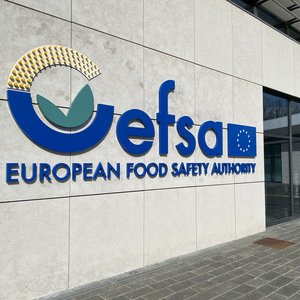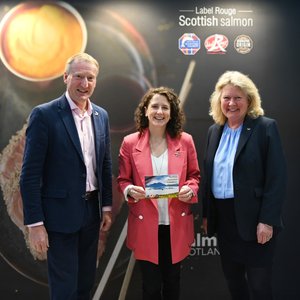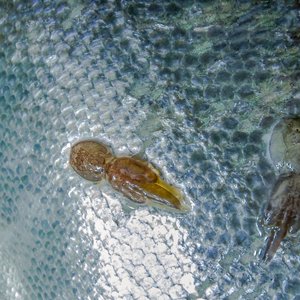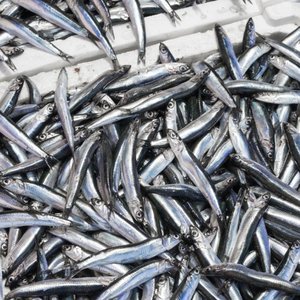Register for the National Stakeholder Meeting on April 30
The National Oceanic and Atmospheric Administration (NOAA) in partnership with the U.S. Department of Agriculture (USDA) launched the Alternative Feeds Initiative on November 15, 2007, to accelerate the development of alternative feeds for aquaculture. The text below describes the purpose of the joint initiative, and provides background information on aquaculture feeds, upcoming events, and publications of interest. For more information, contact the NOAA Aquaculture Program at NOAA.Aquaculture@noaa.gov.
Overview of the Alternative Feeds Initiative
Register for the National Stakeholder Meeting on April 30
Agenda for the National Stakeholder Meeting
Background Information on Aquaculture Feeds
Public Comment (comment period now closed)
Overview of the Alternative Feeds Initiative
The purpose of the NOAA-USDA Alternative Feeds Initiative is to identify alternative dietary ingredients that will reduce the amount of fishmeal and fish oil contained in aquaculture feeds while maintaining the important human health benefits of farmed seafood. Ultimately, the initiative will lead to the commercialization of alternatives for some species which will result in reduced dependence on marine fish resources by feed manufacturers and seafood farmers worldwide. NOAA is partnering with the USDA's Agricultural Research Service and Cooperative State Research, Education, and Extension Service on the initiative, which will build on ongoing USDA and NOAA research to identify alternative protein and oil sources for aquaculture feeds.
The major components of the joint initiative are:
- Solicit ideas and suggestions on alternatives from the public (comment period now closed);
- Convene a panel of U.S. and international researchers to gauge the current state of alternative feeds research and suggest priorities for future research;
- Convene a stakeholder panel to discuss issues associated with feeds, including human health and nutrition factors; the environmental effects of feeds production, such as the pressure on reduction fisheries; ongoing research on alternative ingredients, such as plant proteins; the importance of viable alternatives from a manufacturer’s perspective. This panel will also inform future research priorities (registration now open);
- Develop and distribute a white paper summarizing the results of the two panels and charting the course for the development of alternative aquaculture feeds in the United States.
The National Oceanic and Atmospheric Administration (NOAA) will host the NOAA-USDA National Stakeholder Meeting on Alternative Feeds for Aquaculture on April 30, 2008, in
To register, click here.
Date: April 30, 2008
Time: 11:00 a.m. to 5:30 p.m.
Location: NOAA Headquarters in Silver Spring, Maryland
Address: 1325 East-West Highway
Ro
Directions: Click here for detailed directions and parking information.
The purpose of the Stakeholder Meeting on Alternative Feeds for Aquaculture is to provide a forum for open c
Topics to be addressed at the meeting include the following scientific and practical considerations of alternatives to fish meal and oil in aquaculture diets:
- Human Health & Product Quality Impacts
- Environmental Implications
- Alternative Feedstuff Options
- Future Directions for Feeds Manufacturing
Agenda for the National Stakeholder Meeting
Draft Agenda (posted March 31, 2008)
WEDNESDAY, APRIL 30, 2008
Welc
Dr. Michael Rubino, NOAA Aquaculture Program
Dr. Caird Rexroad, Associate Administrator, USDA-ARS
Dr. Ralph Otto, Associate Administrator ,USDA-CSREES
Moderator Remarks
Dr. Paul Sandifer,
Presentations & Discussion
Human Health & Product Quality Impacts
Dr. Charles Santerre,
Environmental Implications
Dr. Jane Lubchenco,
Alternative Feedstuff Options
Dr. Diane Bellis, Plant Products in Aquaculture Working Group
Future Direction for Feeds Manufacturing
Richard Nelson, Silver Cup Feeds
Breakout Groups
Reports fr
Closing Remarks
Adjourn
Background Information on Aquaculture Feeds
Fish meal and fish oil are important c
The protein and lipid-rich feed pellets used for farmed fish and shrimp have traditionally been made in part fr
In the
On a global scale, significant improvements have been made in reducing the reliance on fish meal and fish oil for feeds for many cultured species. NOAA and other federal agencies play a vital role in that research and the transfer of that technology to industry. The joint feeds initiative will highlight this type of ongoing research and identify new priority areas.
For more information:
New Developments in Fish Feeds and Feeding Practices (pdf, 424 KB)
This presentation, by Dr. Ron Hardy, Director of the Aquaculture Research Institute at the University of Idaho, provides an overview of the issues associated with aquaculture feeds and highlights current research on suitable alternative ingredients. More information on Dr. Hardy is available online.
State of
This report by Dr. Albert Tacon was published in 2005 as part of the World Wildlife Fund Salmon Aquaculture Dialogue. The report provides information on environmental and public health issues related to salmon feed, including the use of fish meal and fish oil. This report is also available online.
United Nations Food & Agriculture Organization (FAO) Publications
The following publications include information on many aspects of aquaculture, including the availability and manufacture of feeds for aquaculture:
State of World Aquaculture (2006)
Global Trade Conference on Aquaculture (2007)
Overview of Aquaculture Feed Manufacturing (2001)
Feeds Technology in Aquaculture
NOAA launched the joint initiative by calling for public input on the development of alternative aquaculture feed. The deadline for c
NOAA was seeking responses in four specific areas:
(1) Groundbreaking research on alternative dietary ingredients (feedstuffs) for aquaculture, including plant based proteins, is expanding the
(2) What are potential alternative sources of protein and oil for aquaculture feeds? For example, are there specific opportunities for greater use of seafood processing waste and other agricultural by-products in aquaculture feeds? Are there specific obstacles to using these alternatives as alternative dietary ingredients in aquaculture feed?
(3) What type of treatments or processes show pr
(4) Fish meal and fish oil contribute important human nutritional c










